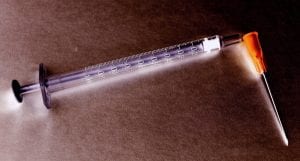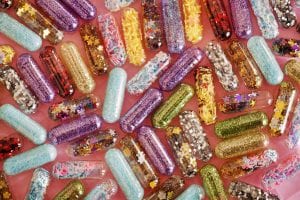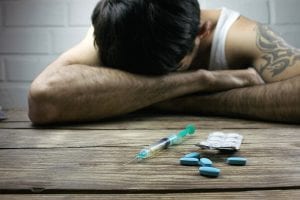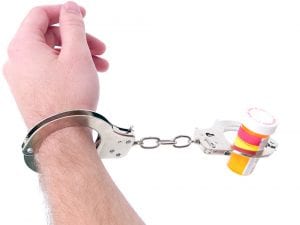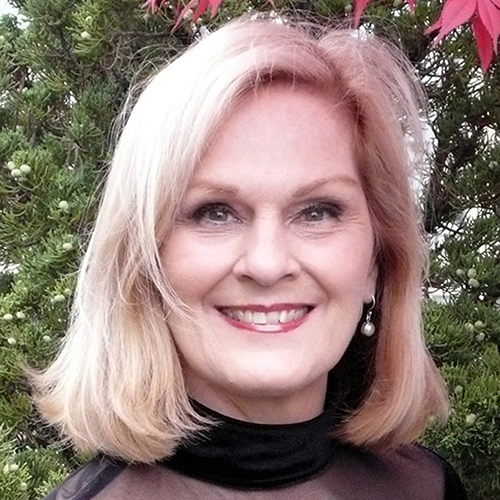“Shenocide” is a coined word, describing the killing of the spirit or shen. Opioid addiction, which effectively destroys the patient’s shen, is responsible for a growing number of deaths worldwide. Opioid addiction has reached epidemic proportions in the United States. Some relevant statistics:
- In 2011, an estimated 4 million people in the US used opioids recreationally and were addicted to them. [1]
- 23 million Americans needed treatment for addiction in 2012, and only 2.5 million actually received treatment.[2]
- Close to 38 million people used opioids illegally in 2013[3] , and the number continues to grow!
As of 2016, the World Health Organization published the following concerning this international crisis:[4]
- About 275 million people worldwide (5.6 per cent of the global population aged 15–64 years) used drugs at least once during 2016. Among them, there were about 34 million people who used opioids and about 19 million who used opiates.
- An estimated 27 million people suffered from opioid use disorders in 2016. The majority of people dependent on opioids used illicitly cultivated and manufactured heroin, but an increasing proportion used prescription opioids.
In this article, we will focus on the treatment of treatment of imbalances that result from opioid addictions.
Three Protocols for Shenocide
These three suggested acupuncture protocols for shen disturbance can be integrated into your acupuncture practice, as palliatives for dependence and symptoms resulting from addiction, in the context of a constitutional treatment. The author has employed all three treatment protocols to good effect, not only for addiction, but also to treat shen disturbance resulting from other issues such as sexual and emotional abuse, spiritual possession, PTSD (post-traumatic stress disorder), and traumatic memory loss. Opioids are substances that are used medically for both acute and chronic pain relief, for reversing opioid overdose, and for suppression of other symptoms. Some of the side effects of these drugs are:
- Drowsiness
- Depression
- Euphoria
- Hallucinations
- Compromised immune system
- Hormonal imbalances
Continuous use can foster dependency and tolerance to the drug; this increases the need for higher doses, and gives rise to intense withdrawal symptoms, when it is discontinued. Withdrawal symptoms include:
- Severe dysphoria
- Manic raving
- Depression
- Irritability
- Nausea, vomiting, sweating
- Tremors and insomnia
Misuse of opioids can cause severe psychological obsessions and contribute both to lack of judgment and dangerous behavior resulting in serious accidents or death.
Are you interested in becoming a certified acupuncture professional?
Visit the links below to explore our specialized acupuncture programs at a campus near you:
Integrating Chinese Medicine for Psychospiritual Treatment
Background
The word “opioid” hearkens back to the earlier drugs classified as opiates, which are naturally derived from the dried latex of the red poppy (Papaver somniferum), the principal one of which is opium, Lachryma papaveris (literally, the “tears” of the poppy plant). Historically, it was one of the most popular drugs used for medical, recreational and religious purposes. In the 3rd century BCE, the Sumerians grew poppies and harvested opium from their seed pods, although the earliest archaeological finds of opium seeds date back to the Neolithic era, approximately 5,000 years ago.
In 1804, Friedrich Wilhelm Adam Sertürner, a German pharmacist, first isolated morphine from the opium poppy, naming it after the Greek god of dreams, Morpheus. Shortly after this discovery, codeine was similarly isolated from opium. In the 1850’s, the invention of the hypodermic needle made possible the injection of these and other substances into the body during surgery, to address post-operative pain, and for general anesthesia. Synthetic morphine derivatives were formulated in the 20th century, and these substances were called opioids, a word which means “opium-like”. A doctor could then give a patient a rapid dose of a desired narcotic; for the recreational user, this translated into the notorious “quick fix” of the drug addict.
Chinese Medicine vs. Western Medical Approaches
In Taoist philosophy, the Three Treasures refer to three intrinsic and inseparable forces that embody Heaven (shen), Humanity (qi) and Earth (jing). In order to promote health, well-being and longevity, it was necessary to refine jing into qi, qi into shen, and shen into openness. This was accomplished by means of a transformative alchemical practice of directing the three jiaos with breath, meditation, and acupuncture, which served to align the practitioner with Heaven (tian) and the Source. Any malaise or manifestation such as an addiction was perceived as originating in an imbalance in all three levels of being and so healing was approached from a holistic perspective.
In contrast, Western medicine tends to target the patient’s symptoms. Consequently, drugs are freely prescribed for chronic, non-cancerous pain. This indiscriminate overmedication can cause severe side effects and result in eventual addiction to the opioids. Since opioids have a sedative action upon the body, they can depress the functioning of the respiratory system, causing patients to lapse into coma. If taken to extremes, the heart will stop, and death is the inevitable result.
Exploring the Pathways of Shen in Treatment
The Old Chinese Axiom: “The Shen Leads the Qi”
The shen, through the medium of thoughts and emotions, leads the flow of qi in our physical being. Shen, being ethereal in nature, is not as dense as the body, and thus, within this corporeal vessel, it can become stagnant. The associated emotions, if not expressed, lodge themselves in the cells, creating a state of psychospiritual toxicity. If this spiritual blockage is not moved through the action of the qi, then the person may seek something or someone to help them forget their longing and emptiness.
The Gui: Ghosts
A Story of How A Demon Affects the Shen
Poney Chiang, PhD, in an article titled Spirits, Ghosts and Chinese Medicine[5], relates a fascinating account of demonic possession, and how a specific acupuncture point was utilized to expel a demon. Apparently, a tui na doctor from China witnessed his aunt exhibit a superhuman ability: she leapt upon the roof of the house. This was followed by uncontrollable dancing, as if she were possessed by a malign spirit.
Her husband, a martial arts instructor, climbed up on the roof to bring her down, but she overpowered him and threw him off the roof without any effort. Due to the tremendous commotion, a crowd quickly gathered and speculated as to whether the doctor’s aunt was possessed by a specific demon.
After several other attempts to subdue her failed, the doctor was instructed by an unknown villager to strike his aunt in her armpits. When he did so, she immediately collapsed, and, upon regaining consciousness, she had no memory of the incident.
Dr. Chiang observes that this point in the axilla could only have been H 1, jiquan, Summit Spring, the entry point of the heart meridian, and the abode of shen. For the gui or “ghost(s)” to affect the shen, it needed to invade the heart. The pain that the possessed woman experienced from the striking of this point caused the gui to depart and return to its original host.
As a metaphor for opioid addiction, this story vividly describes the shen possession that is so apparent in addictive patients. Dr. Chiang also indicates that Ge Hong, the famous Taoist alchemist from the 4th century CE, used painful contact moxibustion to treat madness, rage, and epilepsy. Pain was intentionally inflicted on the body to resuscitate the shen disturbed patient and to dispel the gui/pathogen.
Gui: The Personification of the Shadow
Sun Si Miao (581-682 CE), a Taoist doctor and acupuncturist from the Tang Dynasty, called entities which seek only material sustenance gui, or ghosts. These entities can either be inherited as predispositions that we repeat throughout our lives without any awareness, or take the form of addictions: opioid abuse, alcoholism, eating disorders, smoking, or any imbalance that imprisons the shen.
Gui can be regarded as the embodiment of the “dark” side of the human psyche—forces and drives that remain unconscious. They also can be personifications of all the haunted, suppressed qualities that we have stashed away in our emotional closets, judged by us as negative, wrong, inferior, scary, or frightening. These forgotten shards of ourselves have been shoved down “under the belt”, only to emerge when abnormal stresses or pressures manifest to disturb our daily lives–deaths, loss of employment, divorce, or other traumas.
It is then that the gui emerge from those deep recesses of our being, showing their faces to the light of day. These demons take control, manifesting as fright, fear, depression, rage, and even mania. The shen is disturbed and the gui searches for something to dampen the pain and uplift the spirit. At this time, the euphoric effect of opioids may seem attractive to the suffering person. Jung would have regarded the gui as synonymous with the shadow, because it represents all the orphaned, disembodied, rejected aspects of ourselves.
The late Giovanni Maciocia observed[6] that the Chinese characters for both the hun, the ethereal soul, and the po, the corporeal soul, contain the radical for gui, and that these souls are independent of the mind. In my opinion, this means that humanity possesses free will. While the path of opioid use may originate in conscious choice, however, this addiction eventually robs the person of their capacity to choose, stripping them of their dignity. They are not in control of their impulses. The demons take hold of the “dark forces” of the psyche.
Protocol 1: Gui – The 13 Ghost Points
I have used Sun Si Miao’s 13 Ghost points in my practice and have taught them to students in the Alchemical Level of the 2-year International GOLD STANDARD FACIAL ACUPUNCTURE® Certification Program at Northwestern Health Sciences University. I have also included them in the curriculum of a course that I co-created with my partner MichelAngelo: Vibrational Medicine: 5 Element Intergenerational Patterns and GeneAstrology™. The latter course applies Acutonics® tuning forks to the points and meridians of the body instead of needles. These points are extremely effective when integrated into a constitutional treatment and address anything that imprisons the spirit.
Sun Si Miao first documented these points in his 7th century work The Thousand Ducat Formulas. They relate to the removal of energetic blocks and emotional fixations, and alleviate symptoms of manic depression, epilepsy, fright, bipolar syndrome, mental unrest, and disturbed shen, all of which are categorized as forms of possession. The treatments employ a combination of needles, moxa, and bleeding techniques.
I do not recommend that the practitioner use all 13 of the points in one session, unless exceptional circumstances should indicate that they do so. I usually rotate 2 or 3 Ghost points in each session, and integrate them into a constitutional treatment protocol, focusing on anchoring the yang qi and nurturing the yin.
In my research, I discovered Sun Si Miao’s Ode to Needling the 13 Ghost Points[7], translated into English. Sun Si Miao referred to a “ghost evil” as a disorder associated with demonic possession, and offered the following associated symptoms:
- Seeing ghosts: delusions of ghost-like imagery; hallucinations
- Ghost talk: delirious speech, ranting and raving
- Floating ghost talk: mental unrest, disruption of the spirit
- Floating corpse talk: delirium manifesting during the terminal stages of tuberculosis
- Mad ghost walking: disturbed sleep walking
All the Ghost points address these manifestations of disturbed shen; some of them expel internal and external wind, restore consciousness, and clear heat:
| Point | Pinyin Name | English Name | Sun Si Miao’s Treatment Technique |
| Du 26 | gui gong | Ghost Palace | Needle 0.3-.0.5 cun |
| Lu 11 | gui xin | Ghost Convincing | Needle 0.1-0.2 cun |
| Sp 1 | gui lei | Ghost Fortress | Needle 0.1-0.2 cun |
| P 7 | gui xin | Ghost Heart | Needle 0.3-0.5 cun |
| UB 62 | gui lu | Ghost Road | Warm needle; 3-7 quick thrusts |
| Du 16 | gui zhen | Ghost Pillow | Needle 1 cun |
| St 6 | gui chuang | Ghost Bed | A warm bleeding needle |
| Ren 24 | gui shi | Ghost Market | Needle 0.2-0.3 cun |
| P 8 | gui ku | Ghost Cave | Needle 0.3-0.5 cun |
| Du 23 | gui tang | Ghost Hall | Needle 0.3-0.5 cun |
| Ren 1 | gui cang | Ghost Hidden | Moxa 3 times (men); moxa stick (women) |
| LI 11 | gui cheng | Ghost Official | Warm needle; 3-7 quick thrusts |
| Extra point: Hai Quan | gui feng | Ghost Seal | Prick and bleed the midpoint of the frenulum under the tongue |
Protocol 2: A Rarely Used Psychospiritual Point: SJ 2, Yemen, Fluid Gate
The second treatment protocol involves san jiao 2, a ying-spring point that clears heat from the upper body. It could have been, in my opinion, a 14th Ghost point, although there is no reference to shen in its name.
It is useful in the treatment of local pain, heat, and swelling of the back of the hand, with contracture of the five fingers, referred to as DePuytren’s Syndrome. The san jiao meridian ascends to the head, the outer canthus of the eye, and enters the ear, therefore this point also addresses tinnitus, deafness, earache, headache and other symptoms of heat imbalance. It can also be very effective in the treatment of shen disturbances.
SJ 2, yemen functions:
- Moistens the mucuous membranes and regulates fluids in the upper body
- Calms heat and benefits the eyes and ears
- Calms the Shen
Indications:
- Red and dry eyes and face
- Palpitations, frayed nerves, epilepsy, insomnia, shortness of breath, and psychospiritual imbalances
SJ 2 is the water point on the fire channel, and it transports fluids to the face and head, which cools, moistens and calms this area of the body. The san jiao exterior/interior relationship with the pericardium, which wraps around and protects the heart, the abode of shen, allows SJ 2, yemen, to treat a patient who is unable to “go with the flow,” one who lacks fluidity in their life.
For more serious psychospiritual/shen manifestations, such as manic depression, manic raving, ceaseless laughter or weeping uncontrollably, I needle this point in tandem with Sun Si Miao’s fourth Ghost point, P 7, gui xing, Ghost Heart.
This powerful combination cools and moisturizes the head, face and sinuses, and clears heat from the heart, calming the shen.
Protocol 3: A Japanese Treatment for Opioid Addiction
This third protocol was originally designated for opiate abuse, and addictions that toxify and damage the kidneys. The first point needled is Japanese K 9, zhubin, Guest House. In Grasping the Wind[8], it is explained that the radical zhu means to “attack” and the radical bin means “to expel”, i.e., the pathogen from the kidneys. Zhubin is a xi-cleft point which addresses emergency conditions, and being a yin point, also treats blood and shen imbalances, because the blood rules the shen. This makes it a perfect point for manic depression, fear, fright and chemical toxicity that can arise from opioid addiction.
K 27, shufu, Shu Mansion, is the kidney transporting shu point, where the qi of the kidney is collected. It is a mansion that abundantly contains kidney qi and essence.
Indications:
- Long term addictions, which damage the kidneys
- Opiate addiction: opium, heroin, morphine, codeine and opioids
- Shen disturbances
- Overuse of steroid hormones
- Overuse of anti-inflammatory drugs
Needling Protocol:
Japanese K 9, zhubin, is 3 cun below K 10, yinggu. Needle K 9 perpendicularly and bilaterally, or use direct moxa.
K 27, shufu, is needled bilaterally and transversely toward the Ren Mai, the sternum.
Retain these needles in the body for the entire constitutional treatment unless otherwise indicated.
Conclusion: A Few Insights
“The non-medical use of prescription drugs has been fueled by the medical community’s over-reliance on the use of prescription opioids to treat both acute and chronic pain.” [9] Both medical and non-medical use of opioids has escalated in recent years. It is important for us, as acupuncturists, to collaborate with doctors, therapists and other healthcare professionals in treating and addressing this wound paralyzing our society.
We are representatives of a medical tradition that has endured for thousands of years, that makes use of both logic and intuitive insight. Traditional Chinese medicine is both an art and a science; it respects individual differences and the significance of specific patterns or archetypal imbalances that may arise during the course of treatment.[10] We know how to treat imbalances of shen, such as addiction affecting both the physical and psychospiritual levels. We can compassionately educate patients about change, choice, and the possibility of healing and transforming their lives.
[1] “Report III: FDA Approved Medications for the Treatment of Opiate Dependence: Literature Reviews on Effectiveness & Cost- Effectiveness, Treatment Research Institute”. Advancing Access to Addiction Medications: Implications for Opioid Addiction Treatment. p. 41.; accessed 1/10/18.
[2] Tetrault, Jeanette M.; Butner, Jenna L. (2015-09-03). “Non-Medical Prescription Opioid Use and Prescription Opioid Use Disorder: A Review”. The Yale Journal of Biology and Medicine. 88 (3): 227–233; accessed 1/10/18.
[3] “Status and Trend Analysis of Illict [sic] Drug Markets”. World Drug Report 2015; accessed 1/10/18.
[4] https://www.who.int/substance_abuse/information-sheet/en/; accessed 7/14/19.
[5] Poney Chiang, “Spirits, Ghosts and Chinese Medicine. Oriental Medicine Journal, New Year edition, January, 2008, 25-31.
[6] Maciocia, Giovanni, The Psyche in Chinese Medicine: Treatment of Emotional and Mental Disharmonies with Acupuncture and Chinese Herbs. London: Churchill Livingstone Elsevier, 2009.
[7] Dale, Ralph Alan, Acupuncture: The Special Function Points. North Miami Beach, FL: Dialectic Publishing Inc, 1996.
[8] Andrew Ellis, Nigel Wiseman and Ken Bass, Grasping the Wind: An Explanation into the Meaning of Chinese Acupuncture Point Names. Brookline, MA: Paradigm, 1989.
[9] Tetrault and Butler, op. cit.
[10] Mary Elizabeth Wakefield, Constitutional Facial Acupuncture, London: Elsevier, 2014.
Featured Posts:
- Acupuncture for Opioid Addiction and Pain Management
- Acupuncture’s Role in Solving the Opioid Epidemic: Effective and Safe
- How Acupuncture Can Help in the Opioid Crisis (Infographic)
- Report of Findings of a Clinical Case on Lyme Disease
- Newly Formed Shen Nong Society Looks to the Future of East Asian Herbal Medicine
